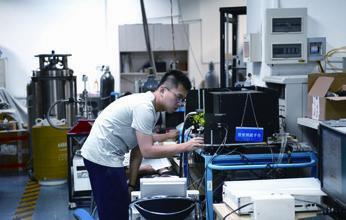Decoding China’s Development Path
By Makhdoom Babar


Many foreign sinologists often suffer from misconception and confusion about China, its governance, society and culture. The three volumes of Xi Jinping: The Governance of China, published in many languages, address the predicament of foreigners wanting to know about China. For me, these books have been the best source to learn about contemporary China, its people, society, foreign policy and the driving spirit behind the countrys remarkable success.
Volume III, a collection of President Xis writings, speeches, policy pronouncements and directions between the 19th National Congress of the Communist Party of China (CPC) in October 2017 to January 13 this year, provides a comprehensive understanding of Chinas priorities for internal reform, development and governance as well as its quest for peaceful reunifi cation.
It also provides valuable knowledge of Chinas foreign policy objective of establishing a community with a shared future for humanity by working toward the goal of transnational prosperity, while maintaining national aspirations and diversity.
A key priority is the poverty eradication effort and delivering the Two Assurances and Three Guarantees for poor rural residents, as enunciated by Xi at a seminar on April 16, 2019. Two Assurances and Three Guarantees means ensuring these people do not have to worry about food and clothing and have access to compulsory education, basic medical services and safe housing.
Anti-poverty leadership
China is undoubtedly the global leader in poverty alleviation. Nowhere in the history of humankind has any system of governance or a politico-economic structure brought such a huge number of people out of poverty. According to statistics, at the end of 2012, there were 98.99 million rural residents living under the poverty line in China. At the end of 2019, the number fell to 5.51 million. This is an enormous reduction of more than 94 percent, equalling 93.48 million people. The poverty alleviation goes hand in glove with socioeconomic uplift and betterment of peoples quality of life and happiness.The Two Assurances and Three Guarantees ensure that the cities and counties implement the plans and measures and closely track their progress, making certain that all households benefi t from them. The target is to achieve moderate prosperity in all respects and the elimination of absolute poverty by 2020, by giving the rural poor access to the basic necessities available to the urban populations.
This goal may have received some setback due to the outbreak of the novel coronavirus disease (COVID-19), but Chinas remarkable handling of the epidemic and quick economic recovery has kept the goal well within reach.
The book elucidates the concepts of the Four Consciousnesses and Four Confi dences, which remain pivotal to maintaining Chinas unhindered path to progress and prosperity. The Four Consciousnesses refer to the need to maintain political integrity, think in terms of the big picture, follow the leadership core, and keep in alignment with the central Party leadership.
Upholding the CPC Central Committees authority and centralized, unified leadership, closely following the Central Committee in terms of thinking, political orientation and actions as well as resolutely implementing its decisions and plans in all work are very important attributes of the Four Consciousnesses.
The Four Confidences refer to confidence in the path, theory, system and culture of socialism with Chinese characteristics.
Another prevalent theme is the maintenance of high quality in development. This requires transformation of the countrys growth model to deal with issues of economic overheating, rising labor costs, nonreplenishable consumption of indigenous resources, environmental degradation and other unsustainable modes of development.
Recognizing challenges
China is fully cognizant of the challenges in the path to development. It is therefore adopting new environmentally friendly technologies. Hi-tech production methods are being adopted in the more developed areas while the labor-intensive industries are being shifted to less developed ones. All these adjustments and restrictions are done to keep in sync with the changing development and socioeconomic needs of the people, through a system created for the purpose.
The nations recourse to science, technology, research and innovations to achieve the set targets has ensured their success. The fruits of this reformation were manifest in the rise of the GDP from 54 trillion yuan ($7.94 trillion) to 99 trillion yuan ($14.9 trillion) between 2012 and 2019. Volume III rightly states that without the leadership of the CPC, national rejuvenation would have been just wishful thinking.
Like in the previous volumes, combating corruption at every level, including among the Party and government offi cials, is an avowed priority of Xi. A prosperous, strong, democratic, culturally advanced, harmonious and beautiful society cannot be built without transparent, fair, responsible and judicious utilization of public and private resources. Xis emphasis has been to exercise strict discipline on offi cials and encourage citizens to develop a corruption-free socio-political culture.
One human community
Volume III, like the previous volumes, also serves as a great source for the international community to deepen their comprehension of Xi Jinping Thought on Socialism with Chinese Characteristics for a New Era and to learn about his approach in taking forward the epoch-making Belt and Road Initiative to build a community with a shared future for humanity.
Responding to the needs of globalization, an integrated economic model with emphasis on connectivity, digital economy, social uplift and shared prosperity with win-win outcomes is being pursued. China has established free trade zones in many provinces and regions, providing a level playing fi eld to local and foreign investors alike, except in specifi c sectors of national importance clearly identifi ed.
Xi Jinping Thought on Socialism with Chinese Characteristics for a New Era and Xis deeds advocate global peace, progress and prosperity. With its globally inclusive development, China has over the years made a major contribution to world peace and development. The all-weather comprehensive strategic cooperative partnership with Pakistan and building a closer ChinaPakistan community of shared future in the new era are a testament to it.
Based on Xi Jinping Thought on Socialism with Chinese Characteristics for a New Era, China has dealt with a host of complex situations both domestically and abroad with remarkable poise. Chinas national response to COVID-19 started in January. Therefore, Volume III doesnt have an account of the remarkable fightback, recovery and post-pandemic rejuvenation. One would have to wait for Volume IV to read about it.

